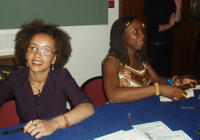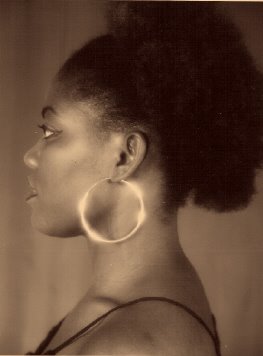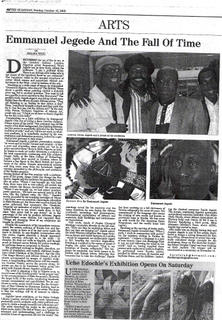 Emmanuel Jegede and the Fall of Time
Emmanuel Jegede and the Fall of TimeBY MOLARA WOOD
Discussing the use of fire in art, at the October Gallery, London, Nigerian artist Emmanuel Taiwo Jegede was in fiery form, telling the audience: "I am a political artist. There is no African alive today who is not aware of the injustices faced by our continent." The 'injustices', relate to the unequal structures of power which ensure and perpetuate Africa's subservience to the West - even in matters of the arts.
Touching on a wide range of issues, he demanded: "Cement in Nigeria; who owns it? The British." News about a gorilla whose painting carried a £14,000 price tag, led to another question. "You want to tell me a gorilla is more superior to Ben Enwonwu?" The gorilla’s work, Jegede argued, was being valued more highly than the efforts of many African artists. "They are dictating to us, fooling us that 'Africa is free'." Then, "somebody brought a shark and they paid 17m for it. Can they pay 17m for African art?" In the end, John Picton, Professor Emeritus of African Art, could only say: "I think we all have to thank (Jegede) for the fire in his belly!"
Commenting on a 1994 exhibition by Emmanuel Jegede (
The Joy of Living a Race, October Gallery), Picton wrote of the artist: "His sculpture has all the marks of his Ekiti background, his painting likewise, and his poetry is manifestly informed by the Yoruba tradition of oriki." And yet, "all his art work, in whatever medium, is as manifestly marked by his own ebullience and distinctive presence, indeed by a spiritual power personal to him alone."
Emmanuel Jegede, a painter, printmaker, sculptor “in wood and in words”, bronze and ceramic - is also a poet and storyteller, since stories are “art in its more narrative form.” Born in Ekiti, Nigeria, in 1943, he began to study art under Akerejola, a sculptor in his local community, continuing with Edo sculptor, Osagie Osifo, at the Yaba College of Technology, Lagos. Jegede later moved to London, where he became a key figure in the Black British Art movement of the 1980s. Despite international acclaim and long years away from his homeland, Jegede remains grounded in the philosophy and aesthetics of his Yoruba ancestry.
Having kicked off the Fire seminar with a performance of his poem,
Sango Onile Ina (Sango the Fire Spirit), Jegede told the audience his grandfather was also an artist. "Where I was brought up, way back then, there were 100 to 200 pillars, all carved; the pots, ornate; the throne, decorated." He continued: "Where I was brought up, we had artists' quarters, poets' quarters… We have our natural patron of the arts, like the Ogboni cults, the Oba…" Jegede's words, preceded by the touching nostalgia of, 'where I was born', were an essential, impromptu education in Ekiti-Yoruba art. For those who cared to know, the artist informed that surnames like 'Onabolu', 'Onasolu' are indicative of artistic lineages. In Ekiti, "artists had six to ten wives", easily done, in fact, since "they never had to pay dowry". As to the patronage of the arts by modern Africans, Jegede acknowledged some decline, but reported that: "Things are changing. Most of my sculptures are bought by Africans."
Despite the constraints of his immediate environment, the artist's embrace of Yoruba lore and language, seems as keen as if he had never made the move to Britain. In non-English conversation with this writer, Jegede observes a deeply ingrained Yoruba courtesy, although he is the older - by decades. He does not write in English, and though much in demand across Britain for poetry readings, he performs them as composed, in Yoruba.
His published writings in English, therefore, are works of translation, and include children's books:
Omo Olode (Children of the Hunter);
Jigi Oju Oba (The King's Mirror); and
African Dream, a book of stories accompanied by images of Jegede's sculptures. A longstanding collaboration with his translator, Gordon Tialobi, moves the process along; 50 poems are due to be translated, before going into print with Karnak House, Jegede's publishers.
The artist is planning a trip to Nigeria soon, to record some of his Yoruba poetry "in the proper way," to the accompaniment of Ekiti drummers. However, the larger body of the works, numbering hundreds, remain untranslated and unpublished. Yet he continues to write; major world events like the devastation of New Orleans by Hurricane Katrina, tend to trigger intense poetic activity in the artist. The hope is that the writings will be of interest to others, someday.
Jegede's latest exhibition, at the Swiss Cottage Library, London, showed how his work "intersects a profoundly poetic aesthetic with wider political concerns to create a deeply beautiful yet subversive art." The artist described the works in the exhibition, titled
Isubu Asiko (The Fall of Time), as a "prayer for tolerance and understanding, and a challenge to invisible forms of oppression all over the world." The paintings reveal the his concerns over the many injustices he sees facing the African continent, including: bad governments, international exploitation of Africa’s raw materials, daily hardships and environmental degradation.
One work,
Ipade O Dogba (Unequal Meeting) comments directly on the G8 summit. "How can they be exploiting Africa and they say they are helping us?" Jegede asked. He cited Western initiatives like sugar factories in Kenya and textile factories in Lesotho - which he suggested, are deliberately rigged to fail, keeping the societies dependent. Pointing at a symbol in the centre of
Ipade O Dogba, the artist informed: "That is my invention of Yoruba calligraphy." The language, he reminded, was never meant to be written with Roman letters. Believing that "someone has to take the challenge," Jegede has been working on a full dictionary of Yoruba calligraphy for some 20 years. His commitment to the language also means the coining of new words not known to previously exist in Yoruba. He has come up with words for The American Space Programme, and the earth's inner core (ogoto).
Speaking at the opening of
Isubu Asiko, Emmanuel Jegede revealed that: "When I work, I work in conjunction with poetry." On the insistent writing in Yoruba, he explained: " I believe a language is a part of your history. Once you disengage from it, you are just following the trend in the world." And so, having supplied those present with explanatory notes in English, he performed more Yoruba poetry, watched by fellow artists, El Anatsui and Tapfuma Gutsa, and his children - including the classical composer Tunde Jegede. The poems, combining Jegede's spirituality and political concerns, included:
Owo Mimo (Holy Hands, about Africa's dependence on Western help) and
Ododo Ni Mi (I Am A Flower). Rendering a third poem,
Ekun Abiyamo (Mother’s Tears, about AIDS), Jegede was moved to tears.
- Isubu Asiko was on display during July and August. Jegede is one of five artists short-listed to design a Living Memorial for Ken Saro-Wiwa. Drawn from 47 artists who originally submitted design concepts for the monument, those on the short-list (including Sokari Douglas Camp) are busy working on their makets. The winner will be announced at a ceremony on November 10.
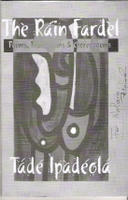

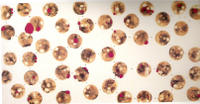



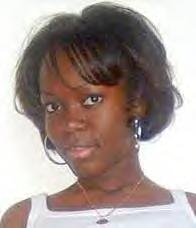

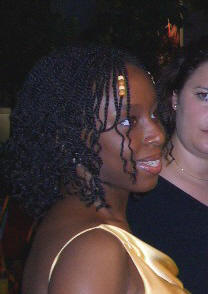
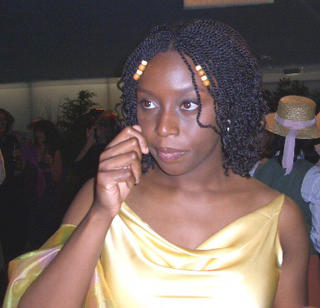



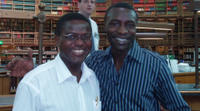
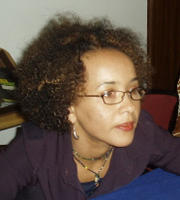
 Chimamanda Ngozi Adichie @ Africa Remix, April 2005 -
Chimamanda Ngozi Adichie @ Africa Remix, April 2005 - 
